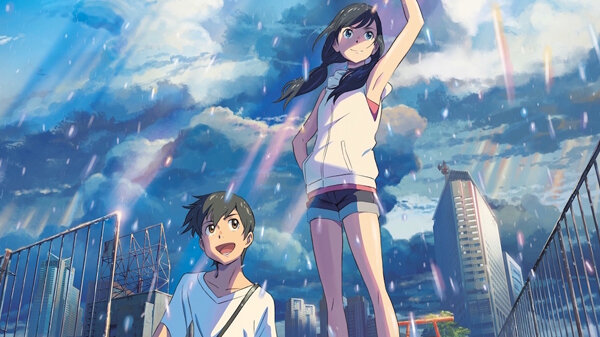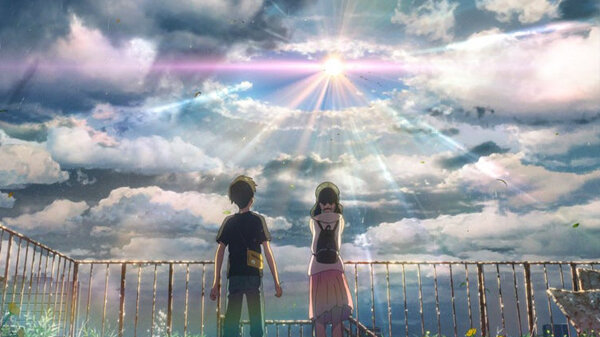The latest teen melodrama from Your Name director Makoto Shinkai reframes women’s labour as warm, sunny – and utterly life-saving. But in anime like in reality, the responsibilities placed on female shoulders are far greater than we realise. Steph Watts investigates the specific and sensitive case of Weathering With You.
On the rooftop of an abandoned building, in an unseasonably wet modern-day Tokyo, a teenage girl and boy stand at a small, remarkably intact shrine. The girl clasps her hands together, deep in concentration, and suddenly a patch of sunlight illuminates the grimy rooftop, chasing away the rain clouds. The boy stares on in amazement; this strange girl has just cleared the skies for a moment, using nothing but her own energy. A sense of hope washes over this early scene of Weathering with You – could she clear the rain slowly drowning the city with this power? Makoto Shinkai’s latest sci-fi teen romance has been seen as an allegory for imminent climate change and the pressure young people face in being tasked with dealing with it. But the story’s real strength lies in its female lead, Hina, who attempts to please everyone around her at the expense of her own sense of self. Are this girl’s actions inherently selfless, or has she been conditioned to feel it’s her duty as a woman to take on such a mammoth role?
The Japanese animation director is probably best known for his 2016 hit Your Name – a magical body-swapping fantasy with almost hysterical levels of drama, that anyone who has been a 16-year-old in love can relate to. It proved hugely popular in Japan, becoming the country’s second highest-grossing film of all time, behind Spirited Away.
In Weathering With You (which was so highly anticipated it surpassed Your Name at the Japanese box office in its opening weekend), 16-year-old runaway Hodoka is trying to survive in the seedy Kabukichō neighbourhood of Tokyo, where it’s been unseasonably raining every day for the past two weeks. While struggling to find a job, stay alive, and feed himself on free McDonald’s soup every night, a girl sneaks him a Big Mac. This is Hina, also a teen, who possesses a rare ability to change the weather – she can create small pockets of sunshine in her immediate vicinity by praying, a skill she’s only recently discovered that she has after saying a quick prayer for a sick relative.
Thrilled to have tracked down a real-life ‘Sunshine Girl’ – someone who, in Japanese folklore, can bring a sunny mood with them wherever they go, a kind of lucky charm in a sense, taken literally in the world of the film – Hodoka suggests they advertise Hina’s services for money, creating income from her power. Hina’s entire career then revolves around the act of bringing joy to others; she clears the skies for a flea market, and makes the sun shine for a father’s trip to the park with his daughter. She even clears the inclement weather over a stadium for a fireworks display.
Hina’s job responsibilities feel inherently gendered – offering happiness and comfort (in Hina’s case, literal warmth) to people as part of an interaction is something many women are often expected to do from a young age. It’s well-documented that women are more likely to be caregivers to family members than men. Even in the home, household chores between heterosexual partners often fall to women on top of their full-time jobs. And if women choose to have children, they may have to decide where to place their energy – their careers, or the wellbeing of their children – in a way that their male partners are less often asked to do. Of course, doing nice things for others feels good, and Hina has good vibes to spare, but the emotional labour that women perform on top of their salaried jobs – tempering their own emotions as well as those of their coworkers – is expected as a character trait purely because of gender.
As Hina continues to produce more and more sunshine throughout the city, parts of her body begin to disappear. They are replaced by iridescent pools of water, like a human-shaped aquarium, as if she is soaking up everyone’s unwanted rain, and simultaneously, their problems. She explains to Hodoka that soon she’ll become pure water, a human sacrifice to the sky, joining the giant rain clouds hanging above Tokyo. She’s so waterlogged with the efforts of making others happy that she loses all sense of her physical self, disappearing in a fast edit and leaving only a deflated dressing gown behind.
Hodoka is understandably upset by Hina’s sudden disappearance – she was one of his only friends in a huge, unwelcoming city caught in continuous downpour. As he searches for her, memories of Hina and their time together run through his mind. But the only memories he can conjure are from times when Hina was there for him; in one memory she’s handing him the Big Mac that saved him from starving, in another, she’s checking up on his mental health, another she’s cooking lunch for him. Hina not only loses her physical being through constant selflessness, but the outline of her personality disappears as well, appearing only to Hodoka in contexts belonging to him. Hodoka values Hina based on what she does for him and how she makes him feel, instead of admiring her for any independent qualities.
Through Shinkai’s classic love of miraculous resolutions as previously demonstrated in Your Name – and a complete disregard for any previously established rules of physics – Hodoka is rocketed into the sky to release Hina from her cloudy prison and bring her back. But if she returns to Earth, the sun will disappear from the sky and the now dangerous levels of rain will continue to fall over Tokyo, possibly never stopping. But as they plummet through the air, Hodoka asks Hina to “pray for yourself”. She has done nothing but pray for others up to this point – her little brother (her only family), her friends, complete strangers. It’s now time for her to stop worrying about what the world wants, and use her energy to make herself happy. As soon as Hina realises it’s not selfish to spend her energy on herself, the film’s emotional resolution bursts into view like the sun pushing through clouds after a long storm, dissipating previous tensions and worries.
Returning to Tokyo three years later, after being captured and taken back to his parents to finish high school, Hodoka picks his way through the city centre – now mostly underwater. Winding his way through the uneven streets, he reaches the neighbourhood that Hina and her brother lived in, hoping to see if they’re still there. He suddenly sees her at the top of the hill. She’s lost in a moment of prayer, the drowned city sprawling out below her. But she’s wholly there, no invisible body parts, nobody weighing her down. Hodoka has a chance to reunite with her and get to know her on her own terms: kindness, selfishness and all, and he takes that chance head on.
Shinkai’s film tackles the guilt that younger generations can often feel about moments of self-centeredness and shortsightedness in the wider context of the climate emergency. It strikes a particular chord with Hinai’s character, sharing a message that even though women are constantly asked to temper and rationalise their feelings for the comfort of others, these feelings are still valid. Teenage girls might be the future of the planet, but they can’t save it on emotional resilience alone.
Steph (@_stephwatts) is a writer, illustrator and podcast producer based in London. She also works with programming collective The Bechdel Test Fest to screen and champion women-led films throughout the year. She strongly believes that The Fast and the Furious: Tokyo Drift is a perfect movie.



